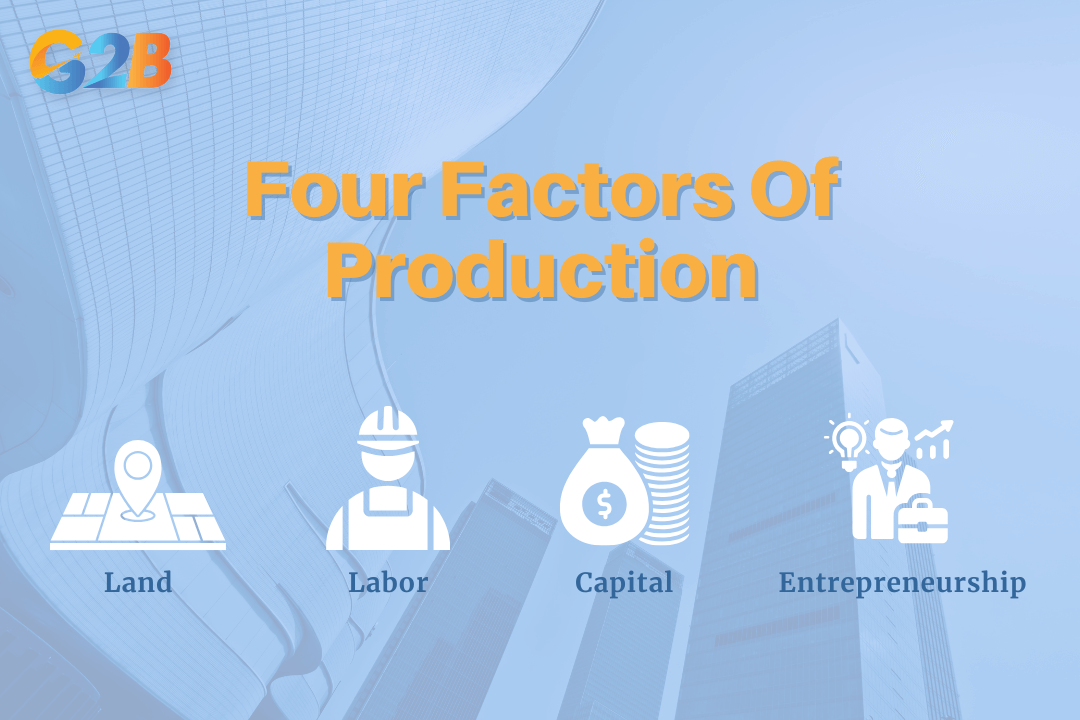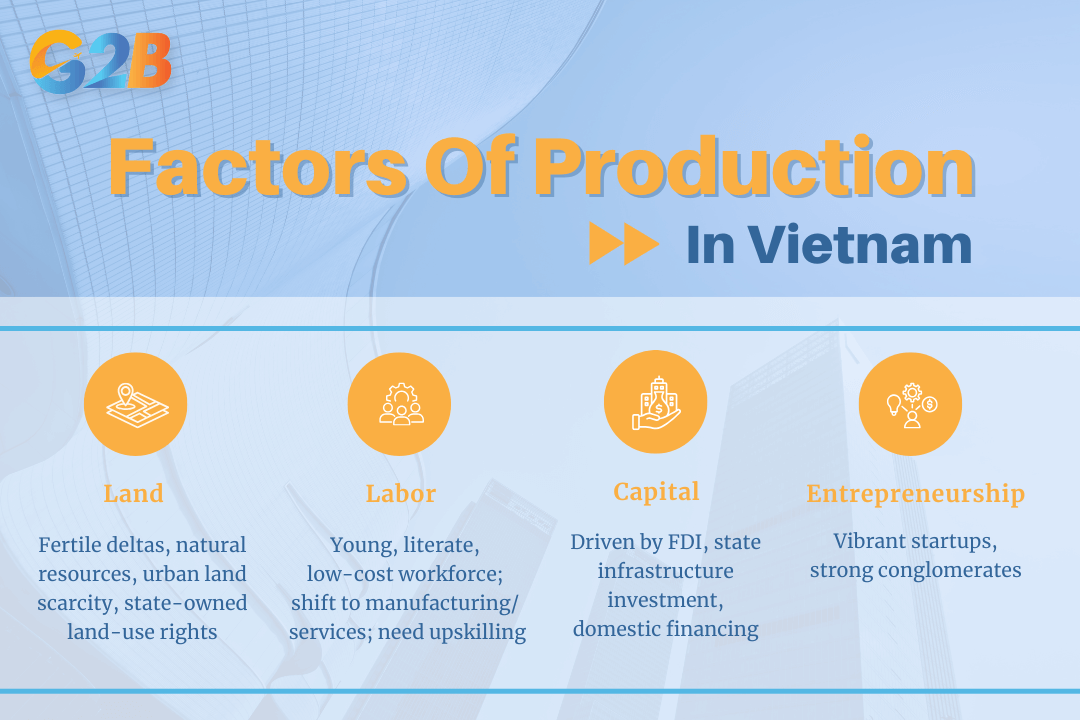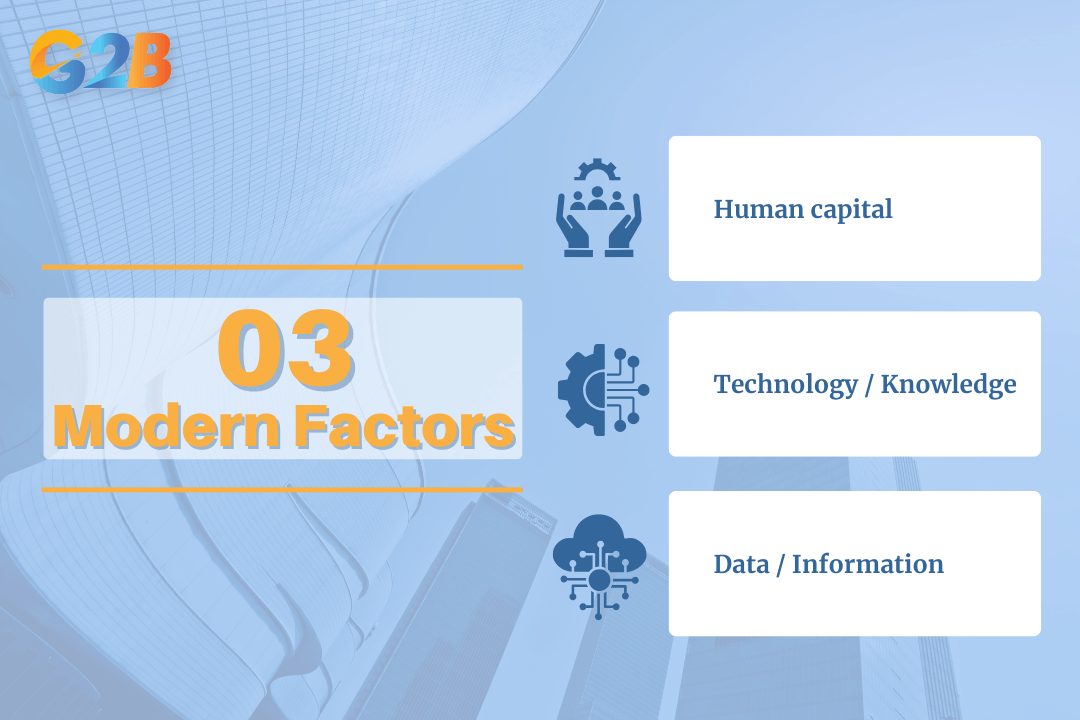Factors of Production are the foundational inputs required to create all goods and services. These elements represent the essential building blocks that drive economic activity, shape industries, and determine how resources are allocated. Understanding each factor, its definition, and its unique function provides businesses, investors, and entrepreneurs with valuable insights into how goods and services are created.
This article outlines the key aspects of the four factors of production to help businesses gain a clearer understanding of their roles and interconnections. We specialize in company formation and do not provide economic or investment advice. For specific financial or operational matters, please consult a qualified legal or financial expert.
What are factors of production?
The factors of production are the essential inputs, resources, or building blocks that are combined in the production process to create finished goods and services. These are the scarce resources that any economy must allocate to satisfy the virtually unlimited wants and needs of its society. In economics, the relationship between the quantities of these inputs and the amount of output is formally known as the "production function."
The study of these factors is central to economics because they are finite, while human desires are infinite. This fundamental problem of scarcity forces societies and businesses to make crucial choices about what to produce, how to produce it, and for whom. Every factor of production commands a payment based on its contribution and market demand; for instance, labor earns rent, and capital earns profit. These payments represent costs to producers and become income for the owners of the factors.
Four factors of production
The classical framework of economics organizes the essential inputs for creating any good or service into four distinct pillars. These foundational elements, land, labor, capital, and entrepreneurship, work in concert to drive all economic activity, from a small farm to a multinational corporation. Each factor plays a unique role and receives a specific form of payment in return for its contribution to the production process.

The 4 factors play a distinct role and earn a specific return in the production process
1. Land
In economics, "land" is a comprehensive term that refers to all natural resources and raw materials gifted by nature, not merely a plot of soil. This factor encompasses a wide range of inputs used in production, from the ground on which a factory is built to the minerals and oils extracted from beneath it, including natural resources that may not be physically attached to the land.
Includes:
- Physical ground, such as real estate, commercial properties, and agricultural acreage.
- Renewable resources, such as timber, wind power, solar energy, and water.
- Non-renewable resources, such as crude oil, natural gas, and coal.
- Minerals and metal deposits, such as iron ore, gold, and bauxite.
Key characteristics:
- Fixed supply: The total quantity of land and its inherent natural resources is finite.
- Passive factor: Land cannot produce anything on its own; it requires the application of labor and capital to become productive.
- Immobile: A specific piece of land or a natural resource deposit cannot be moved from one location to another.
Payment (Income earned):
- The payment for the use of land is Rent.
2. Labor
Labor represents the human effort, both physical and mental, expended in the production process in exchange for remuneration. It is the workforce that applies its skills and time to transform raw materials into finished goods or to deliver services. The value of labor is enhanced by human capital, which is the knowledge and skills workers acquire through education and training.
Includes:
- Physical labor, such as the work of construction workers, mechanics, and farmhands.
- Mental labor, such as the problem-solving of software engineers, the diagnostics of doctors, and the analysis of accountants.
- Service labor, such as the assistance provided by customer service representatives, the service of baristas, and the expertise of teachers.
Key characteristics:
- Perishable: A worker's time cannot be stored; if it is not used, it is lost forever.
- Inseparable: Labor is intrinsically linked to the laborer who provides it.
- Heterogeneous (Variable): The quality and efficiency of labor vary significantly based on a worker's skill, education, experience, and health, collectively known as human capital.
Payment (Income earned):
- The payment for labor is Wages or Salaries.
3. Capital
In the context of factors of production, it is crucial to distinguish that capital refers to physical capital goods, the man-made assets used to produce other goods and services, not financial capital, which is not a factor of production but a medium of exchange and investment tool. Money is not a productive resource itself but facilitates the purchase of capital goods. Capital consists of all the tools, machinery, and infrastructure created by combining land and labor to boost productivity.
Includes:
- Machinery, such as tractors, 3D printers, and assembly line robotics.
- Tools & Equipment, such as computers, delivery vehicles, and hammers.
- Infrastructure, such as factories, roads, warehouses, and fiber-optic networks.
Key characteristics:
- Increases productivity: Capital goods are the primary drivers of labor productivity, allowing workers to produce more in less time.
- Man-made: Unlike land, capital is created through human effort.
- Depreciation: Capital goods wear out, become obsolete, and lose value over time.
Payment (Income earned):
- The payment for the use of capital is Interest.
4. Entrepreneurship
Entrepreneurship is the human element that skillfully organizes, coordinates, and combines the other three factors, land, labor, and capital, into a viable business enterprise. The entrepreneur is the innovator and risk-taker who conceptualizes a product or service and brings it to market in the pursuit of profit. This factor is considered the catalyst that activates the others.
Role:
- The entrepreneur acts as the innovator, strategist, and ultimate risk-bearer and decision-maker of a business venture.
Key functions:
- Innovation: Creating new products, services, or more efficient production processes.
- Risk-bearing: Investing personal time, effort, and capital with no guarantee of a successful outcome.
- Coordination & management: Making the critical strategic decisions that guide the business, from resource allocation to market entry.
Payment (Income earned):
- The payment for the risk and innovation of entrepreneurship is Profit.
Factors of production in Vietnam
Vietnam's economic transformation provides a compelling case study of how the factors of production are leveraged to drive growth. The country's unique endowments and strategic policies have shaped the role of each factor differently than in many other nations.
- Land:
- Key resource: Vietnam's abundant fertile land, particularly in the Mekong and Red River Deltas, establishes it as an agricultural powerhouse, a leading global exporter of commodities like rice, coffee, and cashew nuts.
- Other resources: The nation possesses significant reserves of natural resources, such as coal, crude oil, and bauxite, which fuel its industrial and energy sectors.
- Modern challenge: Rapid urbanization has led to extreme scarcity and high costs for urban land in major economic hubs like Ho Chi Minh City and Hanoi, posing a challenge for further development.
- Legal framework: Land in Vietnam is owned by the state, and individuals or businesses only hold land-use rights under long-term leases or allocations, which affects investment and land management policies.
- Labor:
- Key advantage: A defining feature of Vietnam's economy is its large, young, and literate workforce, often referred to as a "golden population structure."
- Cost: This abundance of labor has kept wages competitive, making Vietnam a highly attractive destination for global manufacturing and a key node in international supply chains.
- Shift: The economy is undergoing a significant structural transformation, with labor moving from lower-productivity agriculture to higher-productivity sectors like manufacturing and services.
- Challenge: To avoid the "middle-income trap," Vietnam faces the crucial challenge of upskilling its workforce, transitioning from a focus on low-cost labor to high-skilled human capital. Additional challenges include managing informal labor markets, internal migration of workers, and addressing underemployment and hidden unemployment.
- Capital:
- Key driver: Foreign Direct Investment (FDI) has been a primary source of modern capital, with multinational corporations, such as Samsung and Intel, building state-of-the-art factories and production facilities.
- State investment: The government has made massive investments in public capital and infrastructure projects, such as highways, airports, and deep-water seaports, to facilitate trade and production. Domestic capital, including bank financing and local investment funds, also plays a significant complementary role in supporting business growth.
- Entrepreneurship:
- History: The spirit of private enterprise was unleashed by the "Doi Moi" economic reforms starting in 1986, which opened the door for private businesses.
- Modern day: Vietnam now boasts one of Southeast Asia's most vibrant startup ecosystems, with notable innovation in sectors like FinTech and E-commerce.
- Conglomerates: Large-scale domestic entrepreneurship is exemplified by powerful conglomerates like Vingroup, which has expanded from real estate (Vinhomes) into high-tech manufacturing with its automotive brand, VinFast.
Vietnam’s dynamic use of land, labor, capital, and entrepreneurship also explains why many foreign investors choose to register a company in Vietnam as a gateway to Southeast Asia. The combination of abundant natural resources, competitive labor costs, and strong government support for innovation creates a fertile environment for business expansion. For entrepreneurs and corporations alike, understanding how these factors of production operate locally is essential before tapping into its fast-growing economy.

Vietnam shapes the role of each factor differently than in many other nations
Modern factors
While the four classical factors provide a foundational understanding of production, the modern global economy, driven by digitization and innovation, relies on new and increasingly crucial inputs. These emerging factors do not replace the traditional pillars but rather amplify their effectiveness and create entirely new avenues for value creation.
Human capital
- Definition: Human capital is the economic value of a workforce's collective skills, knowledge, education, training, and health. It represents a qualitative evolution and an extension of the traditional concept of "Labor," enhancing the quality and productivity of workers rather than replacing labor entirely. It also includes health and soft skills as crucial components.
- Role: The role of human capital is to fuel innovation, enhance adaptability, and drive productivity gains. In today's knowledge-based economy, a highly skilled and educated workforce is often a company's or a nation's most valuable asset and a key differentiator in global competition.
Technology (or knowledge)
- Definition: As a factor of production, technology refers to the application of scientific knowledge, innovation, software, and processes to the production of goods and services. It encompasses everything from proprietary algorithms to advanced robotics. However, in economic theory, technology is often viewed as part of "total factor productivity" - an efficiency factor that enhances the productivity of traditional inputs rather than a standalone factor.
- Role: The role of technology is to act as a powerful amplifier or a "fifth factor" that makes all other factors of production more efficient and productive.
Data (or information)
- Definition: In the digital era, raw data, processed information, and "Big Data" analytics have emerged as a critical input for production and decision-making. For many modern companies, data is the primary raw material they process to create value.
- Role: The role of data is to enable vastly more efficient strategic decision-making, precise customer targeting, supply chain optimization, and accurate prediction of market trends. It is the essential raw material for digital-first companies and a key competitive advantage across all industries.

The modern global economy relies on new and increasingly crucial inputs
The factors of production, land, labor, capital, and entrepreneurship, are the indispensable ingredients that fuel all economic activity. While the classical four factors remain fundamentally relevant, the modern economy has introduced new, powerful inputs like human capital, technology, and data, which act as multipliers, enhancing the productivity of the traditional factors. Understanding this comprehensive framework is essential for business leaders aiming to optimize their operations, for policymakers striving to foster economic growth, and for any individual seeking to comprehend how value is created and wealth is generated in our complex global economy.


 Delaware (USA)
Delaware (USA)  Vietnam
Vietnam  Singapore
Singapore  Hong Kong
Hong Kong  United Kingdom
United Kingdom 
